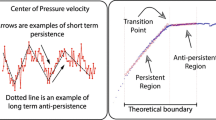Abstract
We introduce a method for quantification of movement sway—spontaneous migrations of the center of pressure (COP) during its voluntary shifts. Subjects stood on a force platform or on a board with a narrow support surface ("unstable board") and performed voluntary cyclic shifts of the COP at different frequencies. Movement sway was typically higher than postural sway; sway in the mediolateral direction was particularly increased. Movement sway showed a drop with the frequency of voluntary COP shifts. During standing on the unstable board, postural sway increased while movement sway decreased. The effects of task parameters were stronger on the sway component in the direction of the voluntary COP shift than in the orthogonal direction. We interpret changes in movement sway with task parameters as partly resulting from modulation of the search function of sway during voluntary COP shifts.










Similar content being viewed by others
References
Alexandrov AV, Frolov AA, Massion J (2001) Biomechanical analysis of movement strategies in human forward trunk bending. I. Modeling. Biol Cybern 84:425–434
Aruin AS, Forrest WR, Latash ML (1998) Anticipatory postural adjustments in conditions of postural instability. Electroencephalogr Clin Neurophysiol 109:350–359
Balasubramaniam R, Riley MA, Turvey MT (2000) Specificity of postural sway to the demands of precision task. Gait Posture 11:12–24
Baratto L, Morasso P, Re C, Spada G (2002) A new look at posturographic analysis in the clinical context: sway-density vs. other parameterization techniques. Motor Control 6:246–270
Bardy BG, Marin L, Stoffregen TA, Bootsma RJ (1999) Postural coordination modes considered as emergent phenomena. J Exp Psychol Hum Percept Perform 25:1284–1301
Breniere Y, Do MC (1986) When and how does steady state gait movement induced from upright posture begin? J Biomech 19:1035–1040
Carpenter MG, Frank JS, Winter DA, Peysar GW (2001) Sampling duration effects on centre of pressure summary measures. Gait Posture 13:35–40
Collins JJ, De Luca CJ (1993) Open-loop and closed-loop control of posture: a random-walk analysis of center-of-pressure trajectories. Exp Brain Res 95:308–318
Duarte M, Zatsiorsky VM (2000) On the fractal properties of natural human standing. Neurosci Lett 283:173–176
Duarte M, Zatsiorsky VM (2002) Effects of body lean and visual information on the equilibrium maintenance during stance. Exp Brain Res 146:60–69
Elble RJ, Koller WC (1990) Tremor. Johns Hopkins University Press, Baltimore
Elble RJ, Higgins C, Leffler K, Hughes L (1994) Factors influencing the amplitude and frequency of essential tremor. Mov Disord 9:589–596
Enoka RM (1983) Muscular control of a learned movement: the speed control system hypothesis. Exp Brain Res 51:135–145
Feldman AG (1986) Once more on the equilibrium-point hypothesis (λ model) for motor control. J Mot Behav 18:17–54
Feldman AG, Levin MF (1995) The origin and use of positional frames of reference in motor control. Behav Brain Sci 18:723–806
Gatev P, Thomas S, Kepple T, Hallett M (1999) Feedforward ankle strategy of balance during quiet stance in adults. J Physiol 514:915–928
Gottlieb GL, Corcos DM, Agarwal GC (1989) Strategies for the control of voluntary movements with one mechanical degree of freedom. Behav Brain Sci 12:189–250
Gurfinkel EV (1973) Physical foundations of stabilography. Agressologie 14:9–14
Gutman SR, Gottlieb GL (1992) Basic functions of variability of simple pre-planned movements. Biol Cybern 68:63–73
Gutman SR, Latash ML, Gottlieb GL, Almeida GL (1993) Kinematic description of variability of fast movements: analytical and experimental approaches. Biol Cybern 69:485–492
Hogan N (1984) An organizational principle for a class of voluntary movements. J Neurosci 4:2745–2754
Horak FB, Shupert CL, Mirka A (1989) Components of postural sway dyscontrol in the elderly: a review. Neurobiol Aging 10:727–738
Horak FB, Henry SM, Shummway-Cook A (1997) Postural disturbations: new insights for treatment of balance disorders. Phys Ther 77:517–533
Johansson R, Magnusson M (1991) Human postural dynamics. Crit Rev Biomed Eng 18:413–437
Latash ML (1993) Control of human movement. Human Kinetics, Urbana, IL
McIlroy WE, Maki BE (1993) Changes in early 'automatic' postural responses associated with the prior-planning and execution of a compensatory step. Brain Res 631:203–211
Mochizuki L, Duarte M, Zatsiorsky VM, Amadio AC, Latash ML (1999) Effects of different bases of support on postural sway. Abstr 23rd Ann Meet Am Soc Biomech, pp 260–261
Newell KM, Corcos DM (1993) (eds) Variability and motor control. Human Kinetics, Champaign
Riccio GE, McDonald V (1998) Methods for investigating adaptive postural control. In: Proc Satellite Meet Soc Neurosci, Nov 6–7, 1998, Los Angeles, CA
Schieppati M, Hugon M, Grasso M, Nardone A, Galante M (1994) The limits of equilibrium of young and elderly normal subjects and in parkinsonians. Electroencephalogr Clin Neurophysiol 93:286–298
Scholz JP, Reisman D, Schöner G (2001) Effects of varying task constraints on solutions to joint control in sit-to-stand. Exp Brain Res 141:485–500
Vaillancourt DE, Newell KM (2000a) Amplitude modulation of the 8–12 Hz, 20–25 Hz, and 40 Hz oscillations in finger tremor. Clin Neurophysiol 111:1792–1801
Vaillancourt DE, Newell KM (2000b) The dynamics of resting and postural tremor in Parkinson's disease. Clin Neurophysiol 111:2046–2056
Winter DA, Patla AE, Prince F, Ishac M, Gielo-Perczak K (1998) Stiffness control of balance in quiet standing. J Neurophysiol 80:1211–1221
Zatsiorsky VM, Duarte M (1999) Instant equilibrium point and its migration in standing tasks: rambling and trembling components of the stabilogram. Motor Control 3:28–38
Zatsiorsky VM, Duarte M (2000) Rambling and trembling in quiet standing. Motor Control 4:185–200
Acknowledgements
We are grateful to Vladimir Zatsiorsky for helpful discussions. The study was supported in part by NIH grants NS-35032 and AG-18751, and by a FAPESP/Brazil grant (#00/03624-5) to M. Duarte. S.S. Ferreira and S.A. Wieczorek are grateful to FAPESP for their scholarships (#01/03429-0 and #00/11363-7).
Author information
Authors and Affiliations
Corresponding author
Rights and permissions
About this article
Cite this article
Latash, M.L., Ferreira, S.S., Wieczorek, S.A. et al. Movement sway: changes in postural sway during voluntary shifts of the center of pressure. Exp Brain Res 150, 314–324 (2003). https://doi.org/10.1007/s00221-003-1419-3
Received:
Accepted:
Published:
Issue Date:
DOI: https://doi.org/10.1007/s00221-003-1419-3




